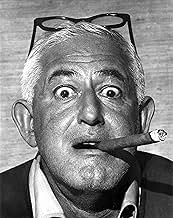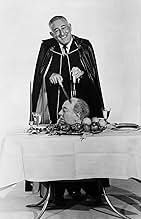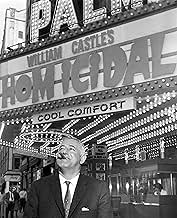IMDb-BEWERTUNG
7,5/10
719
IHRE BEWERTUNG
Füge eine Handlung in deiner Sprache hinzuChronicles the last great American showman, filmmaker William Castle, a master of ballyhoo who became a brand name in movie horror with his outrageous audience participation gimmicks.Chronicles the last great American showman, filmmaker William Castle, a master of ballyhoo who became a brand name in movie horror with his outrageous audience participation gimmicks.Chronicles the last great American showman, filmmaker William Castle, a master of ballyhoo who became a brand name in movie horror with his outrageous audience participation gimmicks.
- Auszeichnungen
- 4 Gewinne & 2 Nominierungen insgesamt
Robert Bloch
- Self
- (Archivfilmmaterial)
Kathy Burns
- Self
- (Archivfilmmaterial)
William Castle
- Self
- (Archivfilmmaterial)
Harry Cohn
- Self
- (Archivfilmmaterial)
Joan Crawford
- Self
- (Archivfilmmaterial)
Ralph Edwards
- Self
- (Archivfilmmaterial)
Mia Farrow
- Self
- (Archivfilmmaterial)
Empfohlene Bewertungen
This documentary seems like a real work of love, as the folks interviewed for the film seem to have a genuine affection for William Castle and his films. If you don't know who Castle is, he was a combination filmmaker and showman--sort of a P.T. Barnum of the 1950s and 60s. Unlike most directors and producers, Castle liked making schlocky films and delighted in creating a wide variety of theater gimmicks to promote them. A few of the crazy marketing strategies he created for his films were life insurance policies to cover you in case you died of fright watching one of his movies, 'emergo'--a skeleton suspended from a wire that flew over the audience, 'percepto' which shocked unsuspecting viewers during scary scenes and much more. To me, however, the film was made better because everyone seemed to admire the guy so much and he was, above all, a good family man. Well worth seeing and just plain fun...just like his films.
By the way, if you like this film and Castle's films, try watching "Matinee", a wonderful homage to Castle and his style of showmanship.
By the way, if you like this film and Castle's films, try watching "Matinee", a wonderful homage to Castle and his style of showmanship.
This 80-odd-minute award-winning tribute to the enterprising cult Hollywood film-maker was included in Columbia's box set dedicated to him released in 2009 which repackaged some of his already existing films on DVD plus debuting some of his rarer stuff; being already the owner of the majority of these, I did not spring for the collection myself and proceeded to acquire this documentary likewise from ulterior sources. In fact, I finished off my 20-title celebration of the great man's centenary with this very item; having just watched the PSYCHETTE: WILLIAM CASTLE AND "HOMICIDAL" featurette from 2002 – included on that film's disc, I realized that not only do they share the same director, but that segments from that 8-minute short were incorporated into the later feature-length look at Castle's life and work.
While most of his more celebrated collaborators have passed on (Vincent Price, Joan Crawford) or declined to appear (Roman Polanski), there is still an impressive gallery of talking heads waxing their genuine enthusiasm for the late cinematic showman: directors John Badham, Budd Boetticher (who himself died back in 2001!), Roger Corman, Joe Dante, Stuart Gordon, John Landis, Fred Olen Ray, Jeannot Szwarc and John Waters, actors Diane Baker, Darryl Hickman and Marcel Marceau, historians Forrest Ackerman, Bob Burns, David Del Valle, Donald F. Glut, Leonard Maltin and Bob Thomas. Although there are some good pre-fame stories – notably desecrating his own theatre and passing it off as Nazi retribution at the start of WWII; meeting with George Stevens in a bar which led to his first Hollywood job as a dialogue director on the Cary Grant drama PENNY SERENADE (1941); and his being hired as an assistant director on Orson Welles' THE LADY FROM SHANGHAI (1948) after getting bypassed for direction – regrettably his generic stint at Columbia under the aegis of producer Sam Katzman is very quickly dealt with and his best film from this early period, the Robert Mitchum/Kim Hunter-starring noir WHEN STRANGERS MARRY aka BETRAYED (1944) does not rate a mention at all.
Once we reach his career-altering departure with MACABRE (1958) early on, at least we are taken in some detail into the production of each of his gimmick-led films up till LET'S KILL UNCLE (1966) but, again, the quintet of outright comedies he made during this phase of his career are completely neglected! The highlight here is hearing about Castle's having to submit to Joan Crawford's every whim on the set of STRAIT- JACKET (1964)! Luckily, I have just acquired a copy of Castle's own memoirs, "Step Right Up: I'm Going To Scare The Pants Off America!" and, hopefully, they will shed some light as to what made him decide to change pace when he had discovered a successful formula after having been denied recognition for so long. Needless to say, the almost inevitable rivalry between Castle and his self-confessed idol Alfred Hitchcock is alluded to and we get to see several personal appearance the director made in the theatrical trailers and screenings of his own movies – not to mention get to listen to his own voice during what seem to be radio interviews.
Apart from the obvious reason of the audiences' changing tastes, I had often wondered why Castle's directorial career suddenly seemed to peter out at the tail end of the 1960s and I never knew that the curse of ROSEMARY'S BABY (1968) – that proved fatal to its Polish composer Krzysztof Komeda and, obviously, Mrs. Roman Polanski herself, Sharon Tate – was also to blame for Castle's semi-retirement as he was struck down with a life-threatening ailment having already been disappointed in being replaced by the much younger auteur! By the time, he went back work, his brand of horror was passé and he only managed to produce a short-lived TV series GHOST STORY (1972-3) – which again is almost entirely omitted here – and the improbably intriguing BUG (1975). Amusingly, director Szwarc decries the fact that his film's box office chances were demolished by its being released on the same day as JAWS but he fails to mention that he got the lucrative assignment of helming its first sequel 3 years later! Thankfully, famous mime Marceau appears here to reminisce about working with Castle on what proved to be his last and finest directorial achievement, the utterly unique concoction SHANKS (1974) – a legitimate home video release of which is elusive to this day. Ultimately, this emerges an entertaining, affectionate and illuminating portrait of a beloved Hollywood personality and, while it also sees the participation of his surviving family members, the film-makers here unwisely elected to finish off with them clowning for the camera...
While most of his more celebrated collaborators have passed on (Vincent Price, Joan Crawford) or declined to appear (Roman Polanski), there is still an impressive gallery of talking heads waxing their genuine enthusiasm for the late cinematic showman: directors John Badham, Budd Boetticher (who himself died back in 2001!), Roger Corman, Joe Dante, Stuart Gordon, John Landis, Fred Olen Ray, Jeannot Szwarc and John Waters, actors Diane Baker, Darryl Hickman and Marcel Marceau, historians Forrest Ackerman, Bob Burns, David Del Valle, Donald F. Glut, Leonard Maltin and Bob Thomas. Although there are some good pre-fame stories – notably desecrating his own theatre and passing it off as Nazi retribution at the start of WWII; meeting with George Stevens in a bar which led to his first Hollywood job as a dialogue director on the Cary Grant drama PENNY SERENADE (1941); and his being hired as an assistant director on Orson Welles' THE LADY FROM SHANGHAI (1948) after getting bypassed for direction – regrettably his generic stint at Columbia under the aegis of producer Sam Katzman is very quickly dealt with and his best film from this early period, the Robert Mitchum/Kim Hunter-starring noir WHEN STRANGERS MARRY aka BETRAYED (1944) does not rate a mention at all.
Once we reach his career-altering departure with MACABRE (1958) early on, at least we are taken in some detail into the production of each of his gimmick-led films up till LET'S KILL UNCLE (1966) but, again, the quintet of outright comedies he made during this phase of his career are completely neglected! The highlight here is hearing about Castle's having to submit to Joan Crawford's every whim on the set of STRAIT- JACKET (1964)! Luckily, I have just acquired a copy of Castle's own memoirs, "Step Right Up: I'm Going To Scare The Pants Off America!" and, hopefully, they will shed some light as to what made him decide to change pace when he had discovered a successful formula after having been denied recognition for so long. Needless to say, the almost inevitable rivalry between Castle and his self-confessed idol Alfred Hitchcock is alluded to and we get to see several personal appearance the director made in the theatrical trailers and screenings of his own movies – not to mention get to listen to his own voice during what seem to be radio interviews.
Apart from the obvious reason of the audiences' changing tastes, I had often wondered why Castle's directorial career suddenly seemed to peter out at the tail end of the 1960s and I never knew that the curse of ROSEMARY'S BABY (1968) – that proved fatal to its Polish composer Krzysztof Komeda and, obviously, Mrs. Roman Polanski herself, Sharon Tate – was also to blame for Castle's semi-retirement as he was struck down with a life-threatening ailment having already been disappointed in being replaced by the much younger auteur! By the time, he went back work, his brand of horror was passé and he only managed to produce a short-lived TV series GHOST STORY (1972-3) – which again is almost entirely omitted here – and the improbably intriguing BUG (1975). Amusingly, director Szwarc decries the fact that his film's box office chances were demolished by its being released on the same day as JAWS but he fails to mention that he got the lucrative assignment of helming its first sequel 3 years later! Thankfully, famous mime Marceau appears here to reminisce about working with Castle on what proved to be his last and finest directorial achievement, the utterly unique concoction SHANKS (1974) – a legitimate home video release of which is elusive to this day. Ultimately, this emerges an entertaining, affectionate and illuminating portrait of a beloved Hollywood personality and, while it also sees the participation of his surviving family members, the film-makers here unwisely elected to finish off with them clowning for the camera...
This movies chronicles the life and times of William Castle. He made a series of low budget horror films in the 1950s-1960s that he sold with gimmicks. In "13 Ghosts" you need viewers to see the ghosts (they were in color, the film was in b&w). "The Tingler" had theatre seats equipped with a buzzer that jolted the audience when a monster escapes into a movie theatre. "Marabre" issued a life insurance policy to all members in case they were frightened to death! The movies themselves were pretty bad but the gimmicks had people rushing to see them. In this doc there are interviews with directors inspired by Castle, actors in his movies and his daughter. It also gets into his home life and the kind of man he was (by all accounts he was a great guy). The documentary is affectionate, very funny and absolutely riveting. It's very short (under 90 minutes) and there's never a dull moment. A must see for Castle fans and horror movie fans. My one complaint--there were very few sequences shown from his pictures. That aside this is just great.
This documentary on schlockmeister William Castle takes a few cheap shots at the naive '50s-'60s environment in which he did his most characteristic work--look at the funny, silly people with the ghost-glasses--but it's also affectionate and lively, with particularly bright commentary from John Waters, who was absolutely the target audience for such things at the time, and from Castle's daughter, who adored her dad and also is pretty perceptive about how he plied his craft. (We never find out what became of the other Castle offspring.) The movies were not very good, it makes clear, but his marketing of them was brilliant, and he appears to have been a sweet, hardworking family man. Fun people keep popping up, like "Straight Jacket"'s Diane Baker, who looks great, and Anne Helm, whom she replaced at the instigation of star Joan Crawford. Darryl Hickman all but explodes into giggles at the happy memory of working with Castle on "The Tingler," and there's enough footage to give us an idea of the level of Castle's talent--not very high, but very energetic. A pleasant look at a time when audiences were more easily pleased, and it does make you nostalgic for simpler movie-going days.
Few in Hollywood understood more what the "show" in Show Business meant than William Castle. Despite the fact that his films were rarely very good, he promoted his pictures and himself so well that he even elicited comparisons to Hitchcock.
Jeffrey Schwarz' Documentary mainly focuses on the period between MACABRE (1958) and I SAW WHAT YOU DID (1965). Castle went heavy on promotional stunts like Death Insurance, nurses in theaters, Emergo's flying skeletons, Percepto's seat buzzers, Illusion-O's 3D-like ghosts, Punishment Polls and Fright Breaks to sell his films. It worked, and Castle was able to distinguish his low-budget movies from that of his competitors such as Roger Corman (who is interviewed).
The movie clips, vintage newsreels and photographs are well-chosen to document Castle's career (too bad Schwarz chose to have everything presented in the same aspect ratio which cuts off the heads, text and other visual information in a number of them). Castle's daughter Terry gives family insight into his personal and professional life along with some of the filmmaker's friends and colleagues like Bob Thomas, actor Darryl Hickman and actress Jacqueline Scott (who just recently passed ). John Waters has some gleeful stories to tell among the the other interviewees like Joe Dante, Leonard Maltin, Michael Schlesinger and Bob Burns.
Castle's reign may have been fairly brief, but, his career stretched all the way back to Columbia Pictures' B unit in the early 40s. It's too bad more time isn't spent on the films for there are a few like the original THE WHISTLER (1944) and JOHNNY STOOL PIGEON (1949) that are on a par with his best known work like HOUSE ON HAUNTED HILL (1959) and HOMICIDAL.
While Castle enjoyed his exploitation success, he wanted to get more respect as a filmmaker, and two stories bookend his career that must have rankled him to his grave. In 1947 Castle found the book that would become LADY FROM SHANGHAI (1947). Castle's version is that he asked Orson Welles to pitch the story to Columbia honcho Sam Cohn with the proviso that Castle Direct. Of course, Welles ended up with the assignment himself. Castle's version probably would have made more sense, but, it would never have had Welles' baroque stylings. In the 60s Castle managed to read and purchase the rights to the galleys of Ira Levin's novel Rosemary's Baby and then flipped those rights for a healthy profit to Paramount Pictures. Again, Castle intended to Direct, but, Paramount's Robert Evans instead hired the the up & coming Roman Polanski. Here again, there is no way to imagine that Castle's Direction could have matched Polanski's bravura style that also captured the zeitgeist of the swinging 60s (to the tune of over $200M in today's dollars). Castle had to settle, again, for a Producing credit. Castle managed to Produce and/or Direct a few more films (including 1975's BUG) before passing away at only 63 (his lifelong smoking of cigarettes and enormous cigars no doubt contributed).
SPINE-TINGLER! is a pleasurable look back at one of the great cult figures of cinema.
While Castle enjoyed his exploitation success, he wanted to get more respect as a filmmaker, and two stories bookend his career that must have rankled him to his grave. In 1947 Castle found the book that would become LADY FROM SHANGHAI (1947). Castle's version is that he asked Orson Welles to pitch the story to Columbia honcho Sam Cohn with the proviso that Castle Direct. Of course, Welles ended up with the assignment himself. Castle's version probably would have made more sense, but, it would never have had Welles' baroque stylings. In the 60s Castle managed to read and purchase the rights to the galleys of Ira Levin's novel Rosemary's Baby and then flipped those rights for a healthy profit to Paramount Pictures. Again, Castle intended to Direct, but, Paramount's Robert Evans instead hired the the up & coming Roman Polanski. Here again, there is no way to imagine that Castle's Direction could have matched Polanski's bravura style that also captured the zeitgeist of the swinging 60s (to the tune of over $200M in today's dollars). Castle had to settle, again, for a Producing credit. Castle managed to Produce and/or Direct a few more films (including 1975's BUG) before passing away at only 63 (his lifelong smoking of cigarettes and enormous cigars no doubt contributed).
SPINE-TINGLER! is a pleasurable look back at one of the great cult figures of cinema.
Wusstest du schon
- VerbindungenFeatured in Attack of the Show!: Folge vom 24. Januar 2008 (2008)
Top-Auswahl
Melde dich zum Bewerten an und greife auf die Watchlist für personalisierte Empfehlungen zu.
Details
- Erscheinungsdatum
- Herkunftsland
- Offizieller Standort
- Sprache
- Auch bekannt als
- Spine Tingler. Historia Williama Castle'a
- Produktionsfirmen
- Weitere beteiligte Unternehmen bei IMDbPro anzeigen
Zu dieser Seite beitragen
Bearbeitung vorschlagen oder fehlenden Inhalt hinzufügen
































